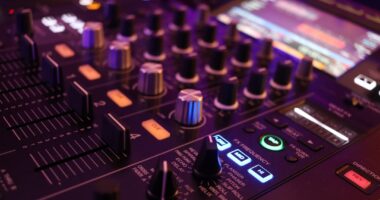Vocal technique is the foundation upon which a singer builds their craft. It encompasses a range of elements, including breath control, pitch accuracy, tone quality, and vocal range. Mastering these components is essential for any vocalist aiming to deliver a powerful and engaging performance.
Breath control, for instance, allows singers to sustain notes and phrases without straining their voices. This involves not only the ability to take deep, diaphragmatic breaths but also the skill to manage airflow during singing. Proper breath support can significantly enhance a singer’s ability to project their voice, making it resonate throughout a venue without the need for excessive volume.
Additionally, pitch accuracy is crucial; singers must be able to hit the right notes consistently, as even slight deviations can detract from the overall quality of a performance. Moreover, tone quality plays a vital role in defining a singer’s unique sound. Different genres often require distinct tonal qualities; for example, a classical singer may focus on a pure, resonant tone, while a pop artist might emphasize a more contemporary, edgy sound.
Vocal range is another critical aspect of vocal technique, as it determines the variety of notes a singer can comfortably perform. Expanding one’s vocal range through exercises and proper training can open up new possibilities for song selection and performance styles. Ultimately, a solid understanding of vocal technique not only enhances a singer’s ability to perform but also contributes to their longevity in the industry, as it helps prevent vocal strain and injury.
Key Takeaways
- Vocal Technique:
- Proper breathing and vocal warm-ups are essential for maintaining vocal health and improving performance.
- Focus on pitch accuracy, tone quality, and vocal control to deliver a powerful and emotive performance.
- Stage Presence:
- Confidence and charisma are key components of a captivating stage presence.
- Utilize body language and movement to engage the audience and convey the emotion of the song.
- Song Choice:
- Select songs that resonate with your personal experiences and emotions to create a genuine connection with the audience.
- Consider the audience demographic and venue atmosphere when choosing songs for a performance.
- Originality:
- Infuse your own unique style and interpretation into cover songs to showcase originality and creativity.
- Experiment with different musical arrangements and interpretations to make familiar songs your own.
- Connection with the Audience:
- Establish eye contact and interact with the audience to create a personal connection and make them feel involved in the performance.
- Share personal anecdotes or stories related to the songs to create a deeper emotional connection with the audience.
- Performance Dynamics:
- Utilize dynamics, such as changes in volume and intensity, to create a dynamic and engaging performance.
- Incorporate variety in performance elements, such as vocal delivery, stage movement, and interaction with the audience, to maintain audience interest.
- Confidence:
- Confidence is essential for a compelling performance; practice and preparation can help build confidence on stage.
- Embrace mistakes and use them as opportunities to showcase resilience and confidence in the face of challenges.
- Adaptability:
- Be prepared to adapt to unexpected circumstances, such as technical issues or changes in the performance environment.
- Flexibility in adjusting performance elements, such as song choice or stage movement, can help ensure a successful and seamless performance.
Stage Presence
Creating a Dynamic Atmosphere
This can be achieved through various means, such as purposeful movement, eye contact, and expressive facial gestures. When an artist moves with intention and interacts with their surroundings, they create a dynamic atmosphere that captivates viewers. The ability to connect with the audience through body language and movement can transform a simple song into an immersive experience.
Emotional Authenticity and Resonance
In addition to physicality, emotional authenticity plays a significant role in stage presence. A performer who genuinely connects with the lyrics and emotions of their songs can convey that passion to the audience. This emotional resonance fosters a deeper connection between the artist and their listeners, making the performance more memorable.
Subtlety and Vulnerability in Stage Presence
Furthermore, stage presence is not solely about being extroverted or flamboyant; it can also manifest in subtlety and vulnerability. Some artists may choose to create an intimate atmosphere by standing still and allowing their voice to take center stage. Regardless of the approach, effective stage presence requires practice and self-awareness, as artists must continually refine their ability to engage and resonate with their audience.
Song Choice

The selection of songs is a critical aspect of any performance, as it can significantly influence how an artist is perceived by their audience. Choosing the right songs involves considering various factors such as vocal range, emotional connection, and audience demographics. A well-chosen song can showcase a singer’s strengths while also allowing them to express their artistic identity.
For instance, an artist with a powerful belt may opt for anthemic pop ballads that highlight their vocal prowess, while someone with a softer tone might gravitate towards more introspective acoustic pieces. The alignment between an artist’s vocal abilities and their song choices is essential for delivering an authentic and compelling performance. Moreover, song choice also reflects an artist’s originality and creativity.
While covering popular songs can attract attention, selecting lesser-known tracks or original compositions can set an artist apart from the crowd. This not only demonstrates artistic bravery but also invites audiences to discover new music alongside the performer. Additionally, considering the emotional landscape of the songs can enhance the overall experience for both the artist and the audience.
A well-curated setlist that flows seamlessly from one song to another can create an engaging narrative arc throughout the performance. Ultimately, thoughtful song selection is a powerful tool that allows artists to showcase their unique voice while connecting with listeners on a deeper level.
Originality
| Category | Metric | Value |
|---|---|---|
| Originality | Number of unique ideas | 25 |
| Originality | Percentage of original content | 80% |
| Originality | Number of patents filed | 10 |
Originality is a hallmark of successful artists in any genre of music. It encompasses not only unique vocal styles but also innovative songwriting and distinct performance approaches. In an industry saturated with talent, originality helps artists carve out their niche and establish a recognizable brand.
This can manifest in various ways, such as incorporating unconventional musical elements into traditional genres or experimenting with different lyrical themes that resonate with personal experiences. By embracing originality, artists can create music that feels fresh and authentic, setting themselves apart from their peers. Furthermore, originality extends beyond just the music itself; it also encompasses visual presentation and overall artistic vision.
An artist’s image—how they dress, their stage design, and even their social media presence—contributes significantly to their originality. For example, artists like Lady Gaga have become icons not only for their music but also for their avant-garde fashion choices and theatrical performances. This multifaceted approach to originality allows artists to engage with audiences on multiple levels, creating a holistic experience that resonates deeply.
Ultimately, embracing originality fosters innovation within the music industry and encourages artists to push boundaries while remaining true to themselves.
Connection with the Audience
Establishing a connection with the audience is one of the most vital aspects of any live performance. This connection transforms a concert from merely a series of songs into an interactive experience where both the artist and audience share in the emotional journey of the music. A strong connection often begins with the artist’s ability to read the room—understanding the mood of the audience and adjusting their performance accordingly.
This might involve engaging in conversation between songs or responding to audience reactions in real-time. When artists acknowledge their listeners’ presence and emotions, it fosters a sense of community that enhances the overall experience. Moreover, storytelling plays a crucial role in building this connection.
Many artists choose to share personal anecdotes or insights related to their songs before performing them. This not only provides context but also invites listeners into the artist’s world, making them feel more invested in the performance. When audiences feel that they are part of something larger than themselves—whether through shared laughter or collective emotion—they are more likely to remember the experience long after it has ended.
Ultimately, creating a genuine connection with the audience enriches both the performer’s experience and that of the listeners, resulting in memorable performances that resonate deeply.
Performance Dynamics

Creating an Emotional Connection
A well-structured performance often includes moments of quiet introspection juxtaposed with powerful crescendos that evoke strong emotions from listeners. By skillfully navigating these dynamics, artists can guide their audience through an emotional rollercoaster that enhances the storytelling aspect of their music.
Building Tension and Release
For instance, starting with softer verses before building up to explosive choruses can create tension and release that captivates listeners. Additionally, performance dynamics are not solely about volume changes; they also encompass pacing and energy levels throughout a setlist.
Creating an Immersive Experience
An artist may choose to alternate between high-energy tracks and slower ballads to keep the audience engaged while allowing them moments of reflection. This ebb and flow can be further enhanced by incorporating visual elements such as lighting changes or choreography that align with the music’s dynamics. By thoughtfully considering these elements, performers can create an immersive experience that resonates on multiple levels—musically, emotionally, and visually—leaving audiences eager for more.
Confidence
Confidence is perhaps one of the most crucial attributes for any performer on stage. It influences not only how an artist presents themselves but also how they are perceived by their audience. A confident performer exudes assurance in their abilities, which can be contagious; when audiences sense this confidence, they are more likely to engage fully with the performance.
This self-assuredness often stems from thorough preparation—practicing vocal techniques, rehearsing choreography, and familiarizing oneself with the setlist all contribute to building confidence before stepping onto the stage. Moreover, confidence allows artists to take risks during performances—whether it’s experimenting with vocal runs or engaging in spontaneous interactions with the audience. These moments of authenticity often lead to memorable experiences for both performers and listeners alike.
However, confidence does not imply perfection; even seasoned artists may encounter unexpected challenges during live shows. The ability to maintain composure in such situations demonstrates true confidence; it shows that an artist can adapt and recover gracefully while still delivering an engaging performance. Ultimately, confidence is a vital ingredient that enhances not only individual performances but also contributes to an artist’s overall career trajectory.
Adaptability
Adaptability is an essential skill for performers navigating the ever-changing landscape of live music events. The ability to adjust one’s performance based on various factors—such as venue size, audience demographics, or even technical difficulties—can significantly impact how well an artist connects with their listeners. For instance, performing in an intimate setting may require different vocal techniques or stage presence than playing at a large festival where energy levels need to be amplified to engage thousands of fans.
Artists who can seamlessly transition between these different environments demonstrate versatility that appeals to diverse audiences. Furthermore, adaptability extends beyond just physical performance; it also encompasses emotional responsiveness during live shows. An artist may need to alter their setlist on-the-fly based on audience reactions or current events that resonate with listeners at that moment.
This flexibility not only showcases an artist’s creativity but also reinforces their connection with fans by demonstrating attentiveness to their needs and preferences. In an industry where trends shift rapidly and unexpected challenges arise frequently, adaptability becomes a crucial asset for artists striving for longevity in their careers. Ultimately, those who embrace change while remaining true to their artistic vision are often best positioned for success in the dynamic world of live music performance.









